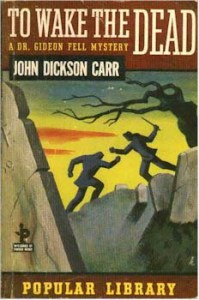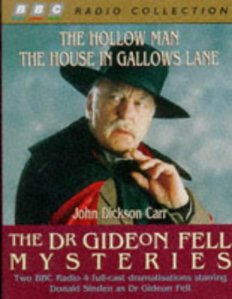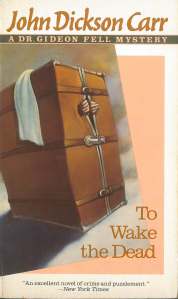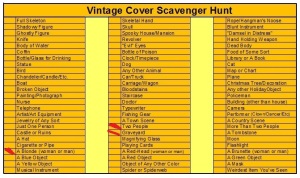John Dickson Carr is my favourite Golden Age mystery author and this entry, featuring his titanic sleuth Gideon Fell, was published when he was at the height of his powers. However, this one isn’t as well-known as many of the other titles he produced at the time. It begins very well indeed when mystery writer Chris Kent, trying to survive on his wits to win a bet, tries to get a free breakfast in a renowned hotel and comes across the body of a woman inside a large trunk …
I submit this review for the Tuesday Night Bloggers meme devoted this month to Carr and hosted by Noah over at his Archives; and Todd Mason’s Tuesday’s Overlooked AV Media meme at his fab Sweet Freedom blog.
Francine: “It’s so horribly ingenious that I can’t believe a word of it.”
Kent runs off to the home of Gideon Fell and finds him in a meeting with Inspector Hadley – they already know about the murder at the hotel, but have several shocks in store for Kent as the woman, battered post-mortem so as to be almost unrecognisable, was Jenny, the wife of Kent’s cousin Rodney, who was himself murdered in almost identical circumstances at the country home of Sir Gyles Gray two weeks before. Kent was meant to meet the pair, and several other friends from South Africa, at that same hotel, which is why he was there – but who would want to murder his well-liked friends? And what about Jenny’s missing bracelet, which then magically re-appears? And who is the phantomatic hotel porter who was spotted at the scene of both crimes? And what of the curious murder method involving towels?
Inspector Hadley to Dr Fell: “By the Lord Harry, I’m going to have one case where you play fair.”

It is quite easy to see why this is considered lesser Carr – it is full of great elements but a lot of them don’t ultimately dovetail. Equally, there are a lot of coincidences (like the business about the two bracelets, Sir Gyles’ previous acquaintance with Jenny and the hotel card floating out of the window) – and then there is a use of a secret passageway to get out of a locked room, which the author would normally have decried and might seriously annoy some readers. Douglas Greene in his biography of Carr tells us that the novel was written at great speed to fulfil a sudden obligation to his publishers, which probably explains why some of the plot points don’t intersect as seamlessly as usual. But, having said that, it is also great fun, the potential for a ‘hidden door’ is in fact signalled quite fairly early on, and the identity of the murderer, revealed in a spooky sequence in a moonlit graveyard, is a great surprise. And while the plot elements are not always woven together as well as they might, they are all in and of themselves highly enjoyable. And in several places Carr does his usual masterful job of tripping up the reader by destroying our most ingenious suppositions about who may have done it. In particular there is a wonderful section in which Fell lectures us and breaks down the case into a dozen crucial but mysterious elements. Even if bits are improbable and some too coincidental, this is tremendously entertaining. But then, I love Carr, and lesser Carr is still better than most in my philosophy!
Melita (Wendy Craig): “So he did know here, but he’d forgotten her. And he might have murdered her, but he didn’t. That’s men for you, isn’t it? So unpredictable. “
In 1997 the BBC broadcast a two-part dramatisation of the book as part of its Gideon Fell series starring the late Donald Sinden – these were all produced and directed by Enyd Williams and dramatised by Peter Ling. The two 45-minute episodes were:
1: The Riddle of the Stone
2: The Secret in the Stone
In adapting it, Ling was extremely faithful to the story, making only a few tweaks by changing the characters from South Africans to Australians (not sure why), moving the story from January to May 1937, to coincide with the Coronation, and removing Wrayburn from the story entirely but partly amalgamating him with Sir Gyles, which actually works extremely well – and in fact by doing so definitely improves on the novel, which is a bit overlong (my edition runs to over 270 pages). Sinden as always makes for an engaging Fell, though admittedly he was not an obvious bit of casting (he might have been better as Merrivale, though I have always fancied Timothy West in the part). Indeed, it is Richard Johnson’s Sir Gyles, in an expanded role, who rather steals the show here. As always with the BBC, the production is technically impeccable, and I am starting to warm to the perhaps too jolly theme music (the composer is uncredited).
The Dr Gideon Fell Mysteries (BBC Radio, 1997-2001):
- The Hollow Man 2 parts (26 March – 2 April 1997)
- The House in Gallows Lane – 2-parts (8-15 October 1997), a re-titled adaptation of Carr’s novel, Till Death Do Us Part
- To Wake the Dead – 2 parts (22-29 October 1997)
- The Blind Barber (5 November 1997)
- The Black Spectacles (9 May 1998)
- The Mad Hatter Mystery (3 July 1999)
- He Who Whispers (25 March 2000)
- Below Suspicion (20 January 2001)

Availability: The first two productions – The Hollow Man and The House in Gallows Lane – were released on audio tape but never on CD. The series is occasionally repeated on BBC Radio 4 Extra and copies are in circulation on the gray market and are well worth finding if you are a fan f radio drama … Also worth keeping an ear out (sic) for The Genius of Gideon Fell, a documentary made as part of the BBC radio series The Radio Detectives by historian Jeffrey Richards devoted to Gideon Fell on radio, including coverage of the early Carr plays from the 1940s.
To Wake the Dead / Gideon Fell (BBC Radio Four, 22-29 October 1997)
Director: Enyd Williams
Producer: Enyd Williams
Scriptwriter: Peter Ling
Cast: Donald Sinden (Fell), John Hartley (Inspector Hadley), David Brooks (Chris Kent), Richard Johnson (Sir Gyles Gray), Wendy Craig (Melita Reaper), Tracy-Ann Oberman (Francine), John Rowe (Dan Reaper). Roger May (Ritchie Bellows), Sarah Rice (Jenny Kent), Iwan Thomas (Inspector Tanner)
I submit this review for Bev’s Golden Vintage Scavenger Hunt in the ‘graveyard’ category:




But then, I love Carr, and lesser Carr is still better than most in my philosophy!
And it’s a good philosophy to have. I hadn’t heard of the radio series, so must keep a lookout for it.
Thanks very much John. The radio show is good fun and because Carr was so involved in the medium in the 40s I am always happy to privilege it here at Fedora!
Lots of Carr adaptations are available on YouTube–see https://www.youtube.com/results?search_query=the+dr.gideon+fell+mysteries+bbc+radio
Having discovered them, I look forward to listening to some, if not all.
Really glad these are available Barry
Thank you Barry – heaven! 🙂
I have to agree with you, Sergio. Carr at his weakest is still better than a lot of people at their best. I admit, this isn’t one I’ve read (shame on me!), but I should. I’d really like to have it as a goal to read at least most of his work, and you’ve reminded me I’m not nearly there yet…
Thanks Margot – there are certainly bettie Carrs out there (I doubt this would be in anybody’s top 10), but I had a great time all the same 🙂
Eventually you and Moira will push me toward actually reading a book by Carr.
You’ve never read John Dickson Carr? B-but that’s heresy!
It is a bit of a worry – but I think we’re winning her over TC 😉
Well I may have actually read some, but if so, long enough ago that I don’t remember. So doesn’t really count.
I find my self in that position more and more, darn it!
You have to do it Tracy – frankly, you owe it to yourself 🙂 pretty much anything from the 30s and 40s is guaranteed to be at least excellent 🙂
Well, where to start? My vote would be The Problem of the Green Capsule/The Black Spectacles. That way, if you don’t enjoy it, you know you’re probably never going to like him…!
I would probably back JJ up completely but in the alternative suggest either She Died a Lady, The Judas Window or The Emperor’s Snuffbox – and lets not forget the results from the Top 10 Carr Poll 🙂
I will look for one of the suggestions, JJ’s or Sergio’s or from the poll. I do check the poll now and then for inspiration. Really.
Eeeeexcellent! 🙂
We are fully expecting you to get there one of these days Tracy
No pressure at all, but you really, really should treat yourself 🙂
Best news I’ve had all day 🙂
As a JDC fanboy I can confirm: a lesser Carr is usually a whole lot better than most mystery writers on their best day. You’ve to go to the mid-1960s (The House at Satan’s Elbow) to find the kind of mysteries that even by his own standards were subpar (Panic in Box C and Dark of the Moon). There’s the earlier, and abysmal, Patrick Butler for the Defense, but everyone is allowed to have an off day. Even Carr.
Thanks TC – I must re-read Panic in Box C because it was one of the first Carrs I ever read and loved it at the time (we’re talking over 30 years ago) – I dare say it pales in comparison with his work from earlier decades – thanks chum.
Very nice, Sergio. It’s been years since I read this so the plot points are more than a little hazy now. I do remember thinking there was a great setup, an especially atmospheric climax in the cemetery, and a pretty entertaining story overall. Perhaps everything doesn’t hang together perfectly in the middle – I’d have to read it again to see about that, but I’ll take your word for the present – but I don’t remember feeling seriously let down by the time I finished it.
Thanks for that Colin – I think you put it very well. There are perhaps a few too many coincidences, but they don’t affect soundness of the main plot, just the air of mystery (i.e. they are really only there for effect). And as for the secret passage, well, yes I would have preferred another solution, but Carr does in fact play fair on this (in context)
Can’t actually recall the details of the secret passage business right now, not necessarily a bad thing as I may well decide to read it again.
In fact, I just pulled my copy off the shelf and have been thinking it over – http://i241.photobucket.com/albums/ff100/Livius_photos/IMG_20160322_114009_zps528clnnb.jpg
Very nice edition matey – I just have the paperback at the top of the review. The book is good in spite of the secret passage business – yes, it makes the villain more unguessable, but would have been a very good surprise anyway, so I’mm well satisfied. Well worth a re-read.
I’ll keep it in mind for Easter, which is still a month off here, as I a Carr story when I have a bit of a break.
You can;t have too much Carr, you can’t 🙂 Glad to lend my audio recording if you are in the mood chum!
Oh, I wouldn’t mind if have the time/chance. And I still owe you a few Carr books but you’ll have to wait till the summer on those I’m afraid.
You have been very generous already my friend – just love Carr!
As you know, I’m a big fan too. And there are, I think, another three titles earmarked for you later in the year.
Sounds bloody spiffing mate!
My pleasure!
And it looks like those audio are there on YouTube – I had no idea: https://www.youtube.com/playlist?list=PL68cuc_mnyj2hTX3tDEheQKsXv9m23LHw
Oh, well spotted!
All down to that ludibundlad 🙂
What I particularly liked about this one was the use of the couple of maps that enable you to work out the schemes if you’re observant enough. I like to think he threw in the ‘secret passage’ as a nod to the readers who would be able to anticipate it on account of those diagrams – no way of proving this, I just think I’m favourably-inclined to anything with a decent crime scene map.
And if this is what he bashes out at short notice on a contractual obligation, wowee!
I know – Carr’s ‘left hand’ work from this era was pretty darn amazing! Not much of a map man myself – frankly, I always get confused anyway!
Speaking of ‘left hand’ – how are you recuperating from your injury chum?
Kind of you to ask; it’s not been plain sailing, but it seems to be properly repaired now. Just a loooong, sloooow glide into wellness to endure. Thankfully, plenty of books to keep me busy!
Glad things are improving chum – hang in there 🙂
Yes, this is a lesser Carr and I agree with your rating of 3. The Secret Passage is a big cheat !
However, I enjoyed reading it.
I think we’re on the same page on this one Santosh! Thanks 🙂
Great to have you doing a Tuesday Night Sergio! I was saying recently that whenever I look through the JDC list I see something I swear I’ve never heard of before – and here’s another one. Will definitely read it some time. And, love Timothy West idea, perfect casting!
Thanks for that Moira – if I could just get the BBC to listen!
Joss Acland?
Oops! Ackland.
I knew what you meant 🙂
Never occurred to me, just because I don’t often think of him in comedic roles, but he can certainly do sinister – probably a bit old for it now though he is still working well into his mid 80s …
88, in fact. I’ve seen him in several comic roles, and he blusters well.
West would be great, I agree. Also Gambon, McKellen . . . (The first time I saw either West or McKellen they were in the same play together at the Edinburgh Festival. I think it was Richard II, could have been Marlowe’s Edward II — they were doing the two in rep, and I can’t remember which I saw first!)
88? Good on him! Actually, McKellen would make for an interesting Fell (with a bit of padding)
Nobody’s thought of Brian Blessed?
Well, he can certainly thunder his way through – well ‘Archon of Athens!’ become the new ‘Gordon’s alive?!’ 🙂
ARCHONS OF ATHENS!!! And if you want someone who’s larger than life, has a piratical swagger, a joy at walking and breathing and talking, and a booming laugh, he’s your man. He’s also a far more SUBTLE actor than people think; see Augustus’s death in I, CLAVDIVS.
I thought he was great in CLAUDIUS but admittedly it has been a while since I saw him in a dramatic role rather than making fun of himself on talk shows.
Pingback: The Tuesday Night Bloggers: John Dickson Carr (Week 4) | Noah's Archives
Great review! You can find the radio adaptations here: https://m.youtube.com/playlist?list=PL68cuc_mnyj2hTX3tDEheQKsXv9m23LHw. Not To Wake the Dead, though.
Thanks for that – I had no idea they were in circulation – hurrah 🙂
Harrumble!
Nicely done!
Cake?
OK, I am now completely lost in the thread of this conversation so have no idea what this now refers to, but cake is always a good think in my view 🙂
Bleak Expectations.
Never actually listened to it though I think I have some episodes lying around in my computer somewhere …
Sergio, I have not read Carr yet. Hopefully, later this year. Thanks for yet another engaging review of his book.
Thanks Prashant – hope you enjoy his work when you get there 🙂
It seems that you have not yet read The Cavalier’s Cup which you purchased in March last year !
I’ve not read it either – been putting it off (haven’t read NIGHT AT MOCKING WIDOW either)
Thanks for featuring this one, Sergio! Makes me wish (again) for more reading time–I read it long ago and far away (pre-blogging–so no real notes on it) and remember very little. Other than it was JDC and I enjoyed it!
Frankly Bev I am in awe of all the reading you do! And yes, Carr is always welcome!
I have a volume of Carr’s radio plays. I’m sure some of the radio episodes might be in there. I’ll have to check it out. Carr is best taken in small doses but when Carr was “on” he was the best roomthe locked-door mystery writers.
I love his stuff so don’t need to parcel his work out – though usually I do just so it will last longer 🙂
I’m another who feels no need to take Carr in small doses — except, that is, for fear of bingeing!
Right on chum! 🙂
I think they changed it from South Africans to Australians because South Africa would make everybody think of apartheid.
Sounds about right.
Well, I checked the 2014 Open Road Media edition and they still mention South Africa and not Australia !
No suggestion that the book was censored / changed Santosh, just the BBC Radio adaptation.
Oh! Now I understand !